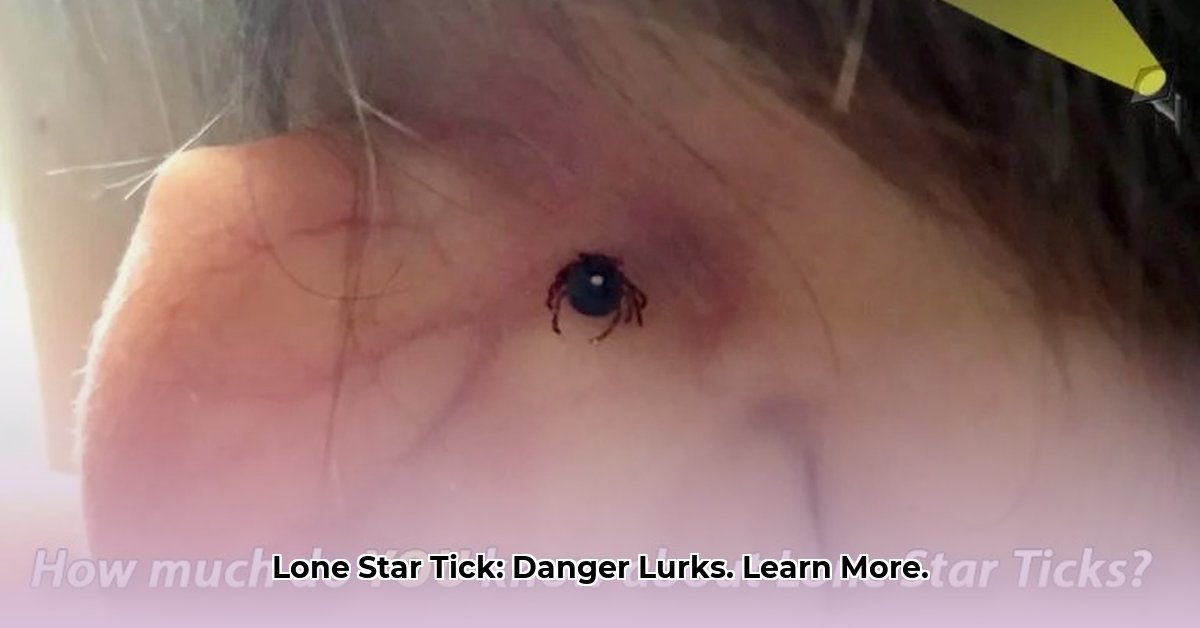Worried about lone star ticks? You’re not alone! These tiny creatures are spreading, and they can carry some nasty diseases. This article will give you a comprehensive understanding of the lone star tick’s life cycle – from its early days as an egg to its adult form – so you can identify them at every stage. We’ll explain the diseases they spread, including that alpha-gal syndrome you might have heard about, and show you why they’re popping up in more places. Most importantly, we’ll arm you with practical, actionable tips to prevent bites and protect yourself and your family. Let’s get you the information you need to stay safe and enjoy the outdoors with confidence.
Lone Star Tick Stages: A Guide to Prevention and Protection
Let’s delve into the world of lone star ticks – tiny creatures that can pack a surprisingly big punch. Understanding their life cycle is your first line of defense against the diseases they can spread. This comprehensive guide will equip you with the knowledge to minimize your risk and safeguard your health.
The Lone Star Tick’s Life Cycle: A Four-Part Story
These ticks undergo a fascinating metamorphosis through four distinct stages, each requiring a blood meal for survival and development: egg, larva, nymph, and adult. This dependence on blood at each stage also presents multiple opportunities for disease transmission.
- The Egg Stage: Origins: The life cycle commences with thousands of eggs laid by a female tick after she has engorged herself with blood. These eggs are typically deposited in secluded, humid locations, often within leaf litter or shaded areas. Due to their minuscule size and concealed placement, encountering these eggs is rare unless actively searching within a tick’s habitat. A single female can lay upwards of 5,000 eggs.
- Larval Stage: Tiny but Numerous: Emerging from the eggs are larvae, often referred to as “seed ticks.” These baby ticks possess six legs and are incredibly small, often described as being about the size of a poppy seed – almost invisible to the naked eye. They are most active in late summer and early fall. Larvae typically congregate in low-lying vegetation, such as leaf litter and grassy areas, where they patiently await their first host. They usually search for their first blood meal in low-lying vegetation, like leaf litter.
- The Nymph Stage: Growing Threat: After successfully obtaining their first blood meal, the larvae detach from their host and molt into nymphs. Nymphs are still relatively small, but now boast eight legs and exhibit more aggressive hunting behavior. They are most active in the spring and early summer. They’re looking for their second blood feast.
- Adult Stage: Reproduction and Risk: Following another blood meal and subsequent molt, the nymph transforms into an adult tick. Adult females are larger and more easily identifiable, particularly by the single white “lone star” marking on their backs. They are also the most dangerous in terms of disease transmission. Adult females are larger and capable of laying thousands of eggs, starting the whole cycle over again. The males, while important for reproduction, don’t actually feed as much.
Understanding these stages is crucial for anticipating when and where you might encounter these pests, allowing you to take appropriate preventative measures.
Where Do Lone Star Ticks Live? And Who’s at Risk?
Lone star ticks are primarily found in the eastern, southeastern, and central United States, with a particularly high concentration in the South. Habitats include wooded areas, grasslands, and areas with dense underbrush. But, thanks to changes in our climate, host animal migration, and environmental factors, their range is steadily growing, with reported sightings now extending into northern states and even Canada. Scientists are diligently studying the rate and extent of this expansion to better predict future risk areas.
Consider your lifestyle and activities to assess your individual risk. Do you spend a lot of time in grassy fields, wooded areas, or hiking trails? Do you have pets that love exploring the outdoors? Do you live near wooded areas? These habits increase your chances of encountering lone star ticks. Even your yard can become a habitat if overgrown with tall grass, shrubs, and leaf litter.
The Diseases Lone Star Ticks Can Carry
These arachnids are vectors for a variety of diseases, posing a significant threat to both human and animal health. Some of the most concerning include:
- Ehrlichiosis: A bacterial infection causing flu-like symptoms, including fever, headache, muscle aches, and fatigue. In severe cases, it can lead to more serious complications.
- Tularemia: Another bacterial infection that can manifest in various forms, ranging from skin ulcers to pneumonia.
- Heartland Virus: A viral infection characterized by fever, fatigue, headache, muscle aches, and decreased appetite. Severe cases may require hospitalization.
- Southern Tick-Associated Rash Illness (STARI): Presents with a rash similar to Lyme disease, but is caused by a different agent and is generally considered less severe.
- Alpha-Gal Syndrome (AGS): This is particularly interesting because it causes a meat allergy that develops after a tick bite. Lone star ticks transmit alpha-gal, a sugar molecule not naturally found in humans. This triggers an immune response, leading to allergic reactions to red meat and other mammalian products. It’s still a relatively new discovery, and researchers are actively trying to understand it better.
The symptoms of these illnesses can vary greatly, ranging from mild flu-like symptoms to much more serious and potentially life-threatening conditions. Early detection and treatment are key to preventing complications. If you suspect a tick bite or develop unexplained fevers, rashes, muscle aches, or other concerning symptoms, seek medical attention immediately.
Staying Safe: Practical Prevention Strategies
Preventing tick bites is the most effective and proactive way to protect yourself and your family from tick-borne diseases. Here’s a practical, step-by-step guide to minimize your risk:
- Regular Tick Checks: After any time spent outdoors, perform a thorough body check – from head to toe. Use a mirror to inspect hard-to-see areas. Pay special attention to areas with hair or folds in the skin, such as the scalp, behind the ears, armpits, groin, and behind the knees.
- Dress the Part: Wear long sleeves and pants, especially when venturing into tick-prone environments. Tuck your pants into your socks or boots to create a barrier and prevent ticks from crawling up your legs. Opt for light-colored clothing, which makes it easier to spot ticks.
- Repellent Power: Apply insect repellent containing DEET to exposed skin. Follow the label instructions carefully, paying attention to reapplication guidelines. For clothing, consider using a permethrin-based spray, which is highly effective at killing ticks on contact.
- Landscape Management: Maintain your lawn regularly by mowing frequently and keeping the grass short. Remove leaf litter, brush, and debris around your property to eliminate potential tick habitats. Create a barrier of wood chips or gravel between your lawn and wooded areas to further deter ticks.
- Pet Protection: Consult with your veterinarian about appropriate tick prevention products for your furry friends. Ticks can easily hitchhike on pets and be brought into your home. Regular tick checks for your pets are essential, especially after they’ve been outdoors.
- Stay on Designated Trails: When hiking or walking in wooded areas, stick to well-maintained trails and avoid walking through tall grass or dense vegetation.
Removing a Tick: A Step-by-Step Guide
If you find a tick attached to your skin, prompt and proper removal is crucial. Follow these steps to minimize the risk of infection:
- Gather Your Supplies: You will need fine-tipped tweezers, rubbing alcohol, soap, and water.
- Grab It Gently: Use the fine-tipped tweezers to grasp the tick as close to the skin’s surface as possible. Avoid using your fingers, as this can increase the risk of infection.
- Pull Straight Up: Pull the tick straight out with a steady, even pressure. Avoid twisting or jerking the tick, as this may cause its mouthparts to break off and remain embedded in the skin.
- Inspect the Bite Site: After removing the tick, carefully inspect the bite area to ensure that no mouthparts remain. If any parts are left behind, try to remove them gently with the tweezers. If you are unable to remove them, consult a doctor.
- Clean the Bite: Thoroughly clean the bite area with soap and water, and then apply an antiseptic such as rubbing alcohol or iodine.
- Monitor and Seek Help: Keep an eye on the bite area for any signs of infection, such as redness, swelling, pain, or pus. If you develop a fever, rash, or other flu-like symptoms, seek medical attention promptly.
The Ongoing Mystery of Lone Star Ticks: What We Still Don’t Know
While significant progress has been made in understanding lone star ticks and the diseases they transmit, much remains unknown. Ongoing research efforts are focused on several key areas:
- Transmission Mechanisms: A deeper understanding of how these ticks transmit various pathogens is crucial for developing targeted prevention and treatment strategies.
- Range Expansion Dynamics: Tracking the rate and extent of their range expansion is essential for predicting future risk areas and implementing proactive public health measures.
- Long-Term Effects of AGS: Further research is needed to fully understand the long-term consequences of AGS and develop effective management strategies for affected individuals.
- Effective Control Methods: Identifying and evaluating the most effective methods for controlling lone star tick populations, including both chemical and biological approaches, is
- Adult Voice Lessons Transform Your Singing and Build Confidence - January 7, 2026
- Vocal Performance Artistry Requires Unmatched Control and Emotional Depth - January 6, 2026
- Understanding Acting Theories and Diverse Methods for Actors - January 5, 2026










